SSM Habitat Restoration: Leque Island and zis a ba
Funded by: Ducks Unlimited
At the mouth of the Stillaguamish River, several projects were conducted in three phases at Leque Island and zis a ba. Leque Island is a 253-acre site owned by the Washington Department of Fish and Wildlife and zis a ba (formerly Matterand) is a 90-acre site owned by the Stillaguamish Tribe.
Phase 1 (2007 - 2008) ♦ Phase 2 (2014 - 2015) ♦ Phase 3 (2016 - 2017)
Phase 1: Leque Island Restoration Feasibility Study, Washington (May 2007 - 2008)
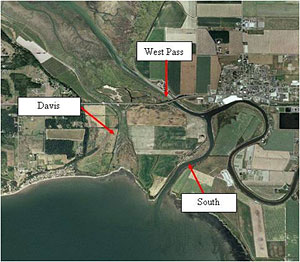
Stillaguamish River/Port Susan Bay
Ducks Unlimited Inc. (DU) has proposed restoration of nearly 50% of the Leque Island historic tidal marsh area, located near the mouth of Stillaguamish River in Washington. This area is currently shielded from tidal action by a dike, and proposed restoration would be accomplished by removing sections of dikes or dike setbacks along the South Pass and Davis Slough branches of the river near its mouth. The project would restore 115 acres of intertidal wetlands on the Leque Island wildlife area. The goal of the project is to restore fish access to the estuary habitat and to create a self-sustaining estuarine marsh area. Battelle was contracted by DU to conduct a hydrodynamic modeling analysis of Leque Island as part of the restoration feasibility study. The overall objective of the study was to evaluate whether the proposed restoration of Leque Island is feasible with respect to hydrodynamic and sediment transport impacts on the restoration site and the surrounding parcels of land.
For this study, a three-dimensional hydrodynamic model for the Leque Island restoration site was developed using the Finite Volume Coastal Ocean Model. The model was used to simulate tidal inundation, tidal currents, and salinity intrusion in the study area for the existing condition as well as for the restored the Leque Island condition, and to evaluate changes in hydrodynamics and circulation at the site. The potential impact on sedimentation in Leque Island under the restoration scenario was also evaluated based on predicted bottom shear stress distributions near the Leque Island restoration area.
Project Highlights
- Model simulations show that the tidal functions can be successfully restored at the Leque Island project site. The duration of tidal inundation in the restoration site would be about 4 to 7 hours per day because of the relatively high bottom elevation of the restoration site.
- Salinity distributions within the restoration site would be in the brackish range because of the influence of freshwater discharge from the South Pass. However, a sharp salinity intrusion was shown to occur during high tide as the restoration area is inundated by the tide from Port Susan Bay.
- Model results indicate that the bottom shear stress distributions in the restoration site are smaller than 0.1 Pa during most of the tidal cycle. Therefore, it is unlikely that erosion would occur in the Leque Island restoration site.
- Because of the low estimates of bottom shear stress distribution at the restoration site, sedimentation could occur if the sediment source is available.
Contacts and Project Team
- PNNL: Tarang Khangaonkar, Zhaoqing Yang, Cheegwan Lee
- Ducks Unlimited: John Axford (PI), Steve Liske
Study Reports and Publications
Yang Z, T Khangaonkar, and C Lee. 2008. Hydrodynamic Modeling Analysis for Leque Island Restoration Feasibility Study. PNWD-3813, prepared for Ducks Unlimited by Battelle, Pacific Northwest Division, Richland, WA.
Phase 2: Restoration Feasibility for the Restoration of Leque Island and zis a ba
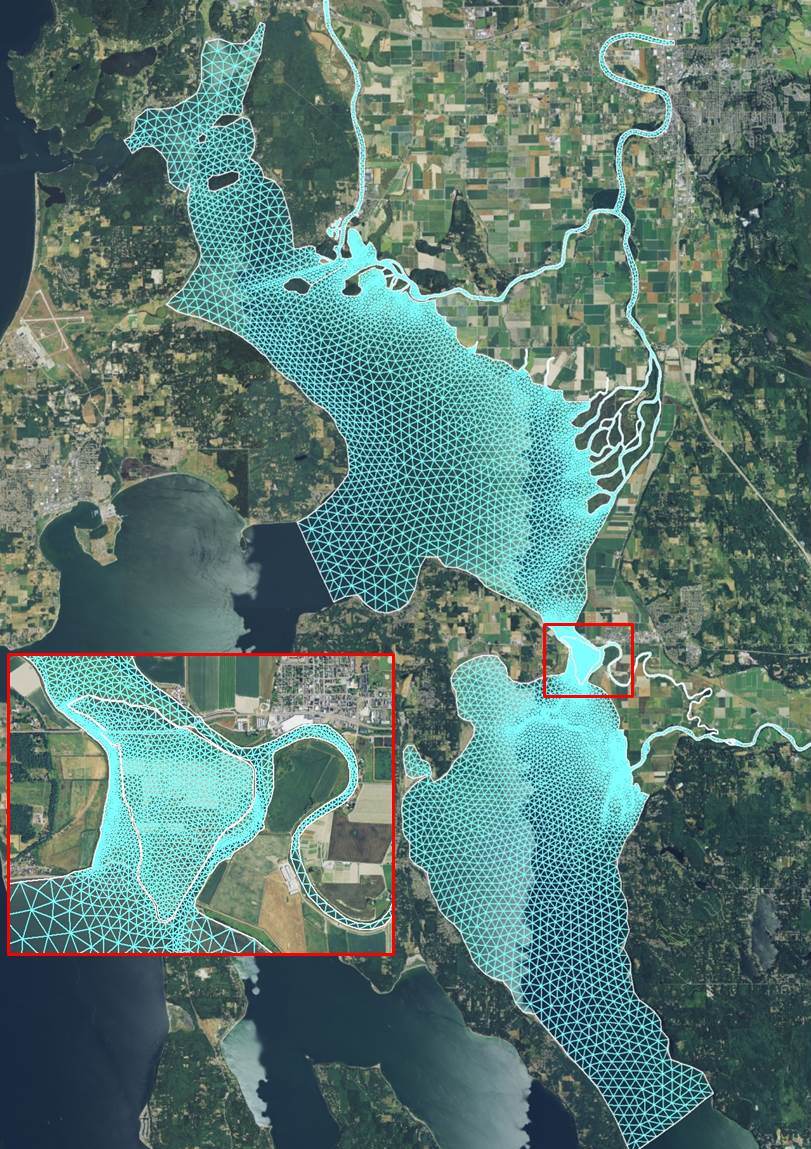
Two sites along the mouth of the Old Stillaguamish River were assessed for habitat restoration involving the removal or modification of existing perimeter dikes at both locations. Leque Island is a 253-acre site owned by the Washington Department of Fish and Wildlife and zis a ba (formerly Matterand) is a 90-acre site owned by the Stillaguamish Tribe. PNNL supported Ducks Unlimited Inc. (DU) with hydrodynamic modeling to evaluate the performance of several proposed restoration actions in terms of achieving habitat goals while assessing potential hydraulic and sediment transport impacts to the site and surrounding parcels of land.
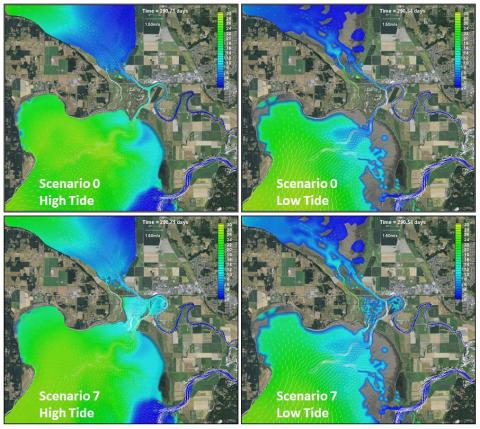
A previously-existing grid was refined and validated to tides, currents, and salinity for the period of October 10-26, 2005. Eight proposed restoration alternatives were then compared with the baseline condition across both a typical flow condition and a bank full flow condition. A year-long simulation with 2003 historic conditions was also examined to assess stakeholder concerns including flood risk to neighboring lands, erosion control, and potential channel migration.
Project Highlights
- Restoration of estuarine functions to the Leque Island and zis a ba sites appears to be feasible for all scenarios based on simulation results.
- It was assessed how frequently salinity, inundation, and bed shear stress are within the desired levels on an annual basis.
- The two projects do not appear to significantly impact one another, based on model results.
- Results addressed a number of site-specific questions and concerns related to impacts of the proposed restoration on neighboring infrastructure such as dikes, outfalls, docks, and pipelines with respect to inundation, sedimentation, and erosion.
Contacts and Project Team
- PNNL: Tarang Khangaonkar, Jonathan Whiting
- Ducks Unlimited: Steve Liske
Study Reports and Publications
Whiting J and T Khangaonkar. 2015. Hydrodynamic Modeling Analysis for Leque Island and zis a ba Restoration Feasibility Study. PNNL-24023, prepared for Ducks Unlimited by Pacific Northwest National Laboratory, Seattle, WA.
Phase 3: Detailed Hydrodynamic Assessment of the Preferred Restoration Alternatives near Leque Island and zis a ba, Washington
PNNL has supported Ducks Unlimited Inc. (DU) with hydrodynamic modeling for the Stillaguamish River estuary in connection with feasibility assessment for the Leque Island Restoration project since 2005. Hydrodynamic feasibility addresses the capability of the proposed actions to restore tidal functions such as periodic inundation, suitable currents, desired habitat/salinity levels, and examines sediment impacts, including the potential for excessive erosion or sedimentation requiring maintenance. A hydrodynamic model of the site, including Skagit Bay, Port Susan Bay, and the interconnecting region of Leque Island, was developed. The model was used to simulate tidal inundation, tidal currents, and salinity intrusion in the study area for the existing condition and to evaluate potential hydrodynamic changes following future restoration in Leque Island.
The configuration of the selected restoration designs at Leque and zis a ba sites were incorporated into the modeling framework with a high-resolution grid of selected regions. The model was applied with a focus on site-specific questions related to impacts of the selected alternatives on neighboring infrastructure such as dikes, outfalls, and pipelines with respect to inundation, sedimentation, and erosion. Results were based on a 2-week period from October 5, 2005 through October 26, 2005. The project assessed: (1) hydrodynamic response of the system for the proposed restoration alternative designs relative to existing conditions, (2) hydrodynamic response of the system for high flow condition, and (3) wave and storm induced exposure to extreme high-water surface elevations from Port Susan Bay. The results were examined relative to baseline at specified locations of interest.
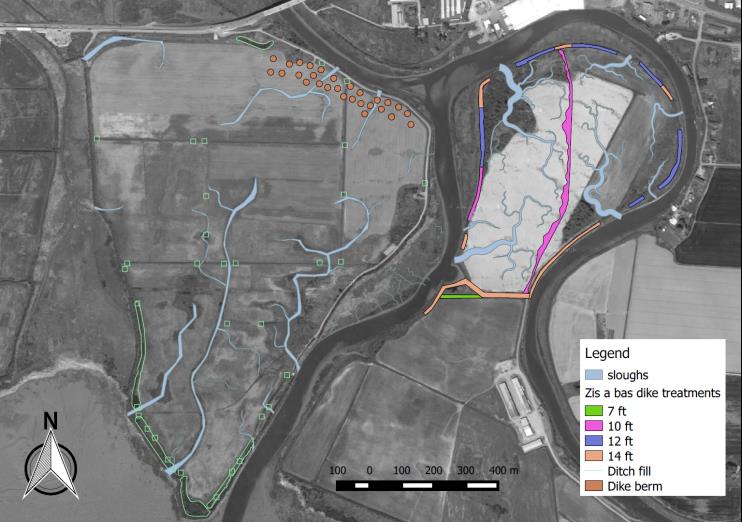
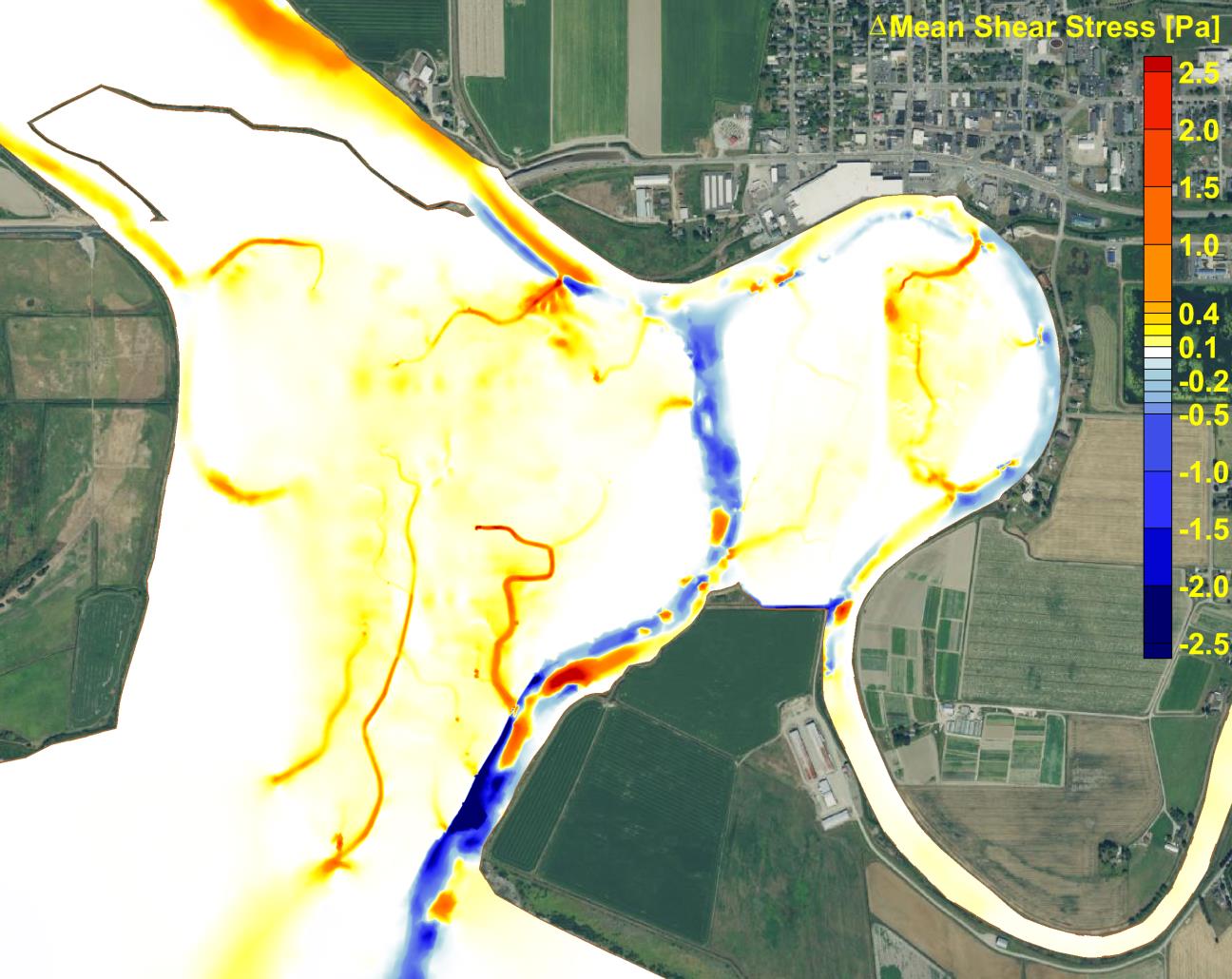
Project Highlights
- The hydrodynamic model was a useful tool in providing a broad understanding of tidal processes (flooding, ebbing, and salinity intrusion) in the Stillaguamish River estuary and near the study sites.
- The preferred restoration scenario involving full dike removals at the Leque Island and zis a ba sites provided the desired response with sufficient inundation and dewatering without ponding or excessive risk of erosion.
- From the assessment of wave and storm induced exposure to extreme high-water surface elevations, the full dike removal at Leque indicated a potential exposure to wave and storm induced surge for the City of Stanwood, north of Leque Island.
- Model results helped alert the team and a detailed wave impact assessment was initiated. The results will dictate the need for a protective dike section along the southern bank of West Pass of Stillaguamish River.
Contacts and Project Team
- PNNL: Tarang Khangaonkar, Adi Nugraha
- Ducks Unlimited: Steve Liske
- Stillaguamish Tribe: Jason Griffith
Study Reports and Publications
Nugraha A, T Khangaonkar. In Preparation. Detailed Hydrodynamic Assessment of the Preferred Restoration Alternatives near Leque Island and zis a ba sites. PNNL-XXXXX, prepared for Ducks Unlimited by Pacific Northwest National Laboratory, Seattle, WA.